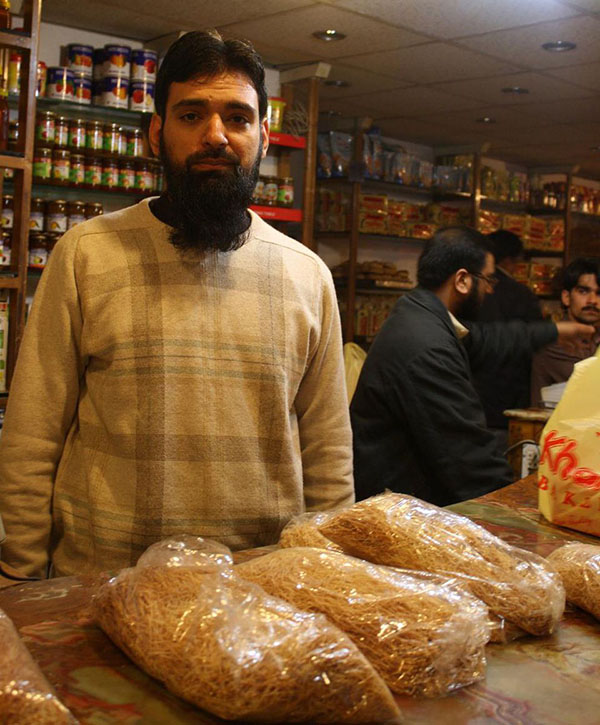Written by: Sadaf Shahzad
Posted on: August 26, 2020 |  | 中文
| 中文
A Fresh Batch of Naan Khatai Out of the Oven
For many in the Subcontinent, the naan khatai is the ultimate tea time snack. Although one grows up with the fresh, crispy batch of biscuits from the local bakery, it was the Naan Khatai of the famed Khalifa Bakery, whose praises I grew up listening. After moving to Lahore, and scouring Mochi Gate countless times in vain to find the Bakery, I had finally seen the bright yellow sign hanging over the narrow street. And it was definitely worth the effort, as the delicate, flaky surface of the naan khatai breaks into a burst of almond goodness, which is sweet but not overpowering.
A Naan Khatai is a shortbread biscuit that is quick and easy to make, with not a lot of sodium content. It is made with semolina, gram flour, sugar, butter, and topped with nuts (usually almond or pistachio) for flavor. Traditionally, the recipe does not include eggs, but some present-day iterations do use ingredients like egg or vanilla essence to experiment and innovate on the classic flavor. It is said that the term comes from the word ‘naan’ (bread) and the Persian word ‘Khatai’, which means biscuit. Others suggest that ‘Khatai’ means ‘six’, denoting the six original ingredients which make it.
Some historians trace the origins of this delicious snack to the port city of Surat in Gujrat towards the end of the 16th century. Dutch explorers had set up a bakery to provide bread for their own, and when they left, they handed over that Bakery to an Indian Parsi servant named Dotivala. Dotivala could not sell the Dutch bread due to the alcohol content in its ingredients, and demand for the bread decreased significantly. Dotivala sold the dried out bread to the underprivileged at a discounted price, and to his surprise, they enjoyed dunking the expired bread in a hot beverage.
As the popularity of this bread grew, the savvy businessman decided to turn the bread into bite-sized biscuits to be sold in large quantities. To market his new product, he named it ‘Naan Khatai’ or Cathay Bread (which was the name of a similar kind of bread available in Persia at the time), as Persian cuisine was popular during the time of the Mughals. The biscuits were transported in bulk from Surat to Bombay via the large Gujrati population which resided in Bombay.
It did not take long before Mughal rulers caught wind of this new treat, and were particularly interested in the Persian flavors which this dish boasted. The Naan Khatai became a delicacy served to the royals and servants alike, on celebratory occasions. They were still popular when the British arrived, and the famous Hobson-Jobson glossary of Anglo Indian words recorded them as Nuncaties, “rich cakes made by the Mohammadens in West India, chiefly imported into Bombay from Surat”. Perhaps it was the biscuit’s popularity in Mughal courts which allowed it to be associated as a Muslim snack, as opposed to a Gujrati delicacy. But even in the present day, a Naan Khatai is supposed to evoke a feeling of royal grandeur associated with the Mughals.
Khalifa Bakery was started by a man named Baba Umer in 1925. After moving from Amristar, India to the narrow streets of Mochi Gate in Lahore, Baba Umer settled in a small haveli, not too far from the Bakery’s current location. Much like Dotivala before him, Baba Umer’s business was not too successful, and he relied on a supplier to make his biscuits. It was when Baba Umer changed the recipe to incorporate crunchy almonds that people began to take notice. Baba expanded his shop to include a production unit in a three-storied kitchen right next to the bakery.

Umer Farooq, Baba Umer's great-great-grandson who currently manages the Bakery (photo credits to Sonya Rehman)
Four generations later, Baba Umer’s family business is still going strong, and they are happy to answer questions about the history and process of making Naan Khatais. On average, the Bakery produces about 2600 kg of biscuits in a day. The biscuits arrive fresh early in the morning, and new batches are constantly flying into the jam-packed store. There is usually a large line of customers outside the bakery, and the Bakery has standardized prices to prevent black market biscuit trading.
While the bakery has expanded to incorporate more flavors and kinds of biscuits and cakes, its baseline recipe remains the same: flour, sugar and clarified butter (ghee). Khalifa has also experimented with other Naan Khatai fillings like Apple, Coconut and Date, but it is the original Almond Khatai which still reigns supreme. Customers from all over Pakistan venture to Lahore to acquire boxes for their families, and foreign dignitaries who visit the city, often leave with a big box of fresh Naan Khatai.
Nowadays commercial businesses have mass-produced the Naan Khattai, as a way of bringing this largely Punjabi snack to the rest of the country. However, it is the local bakeries like Khalifa which keep the authentic taste of the Naan Khatai alive, by honoring the fresh ingredients required to make them. While the Naan Khatai’s story is one of invention and ingenuity, it has consolidated its place as the perfect tea time snack for the people of the Subcontinent throughout history.
You may also like: